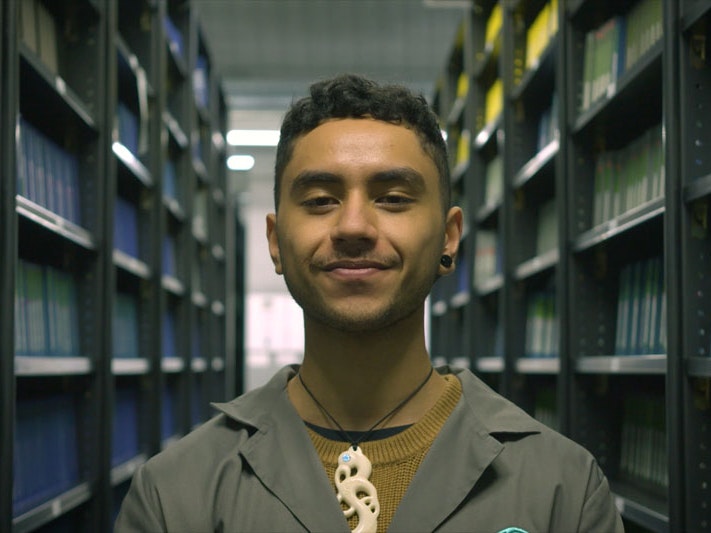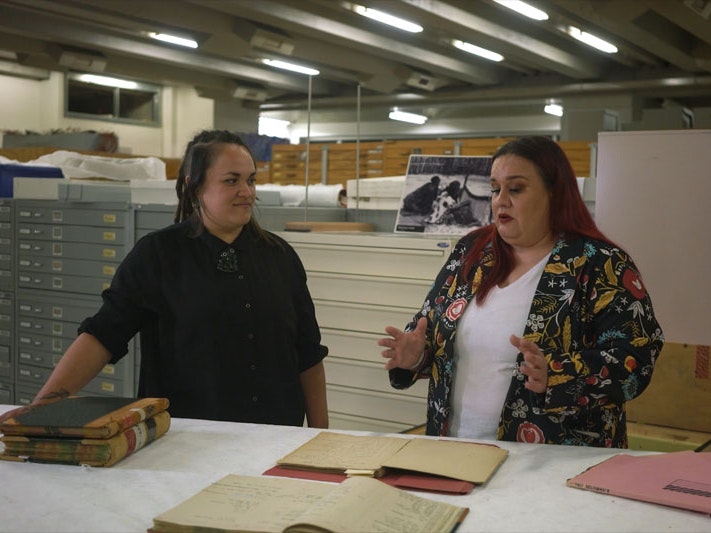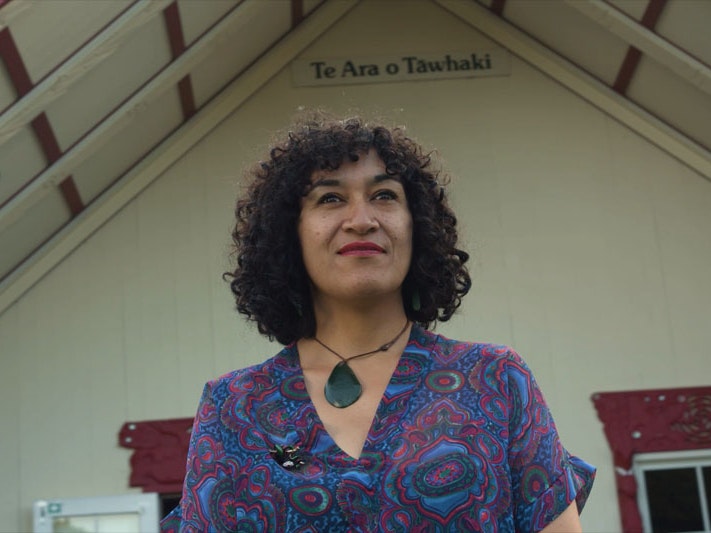In episode one, Khali was inspired by the taonga she saw in the collections at Te Papa. The craftsmanship and curious spirit of our tīpuna is evident. Now it’s time for episode two! Khali wants to meet up a contemporary ringatoi Māori to talk about how we might use the collections as inspiration, and a chance to connect with the mātauranga of our tīpuna.
She meets Keri-Mei Zagrobelna (Te Āti Awa, Te Whānau-a-Apanui), a jewellery maker in Te Whanganui-a-Tara. Keri-Mei talks about her history with the collections at Te Papa, which spans all the way back to the work of her kuia. In her artist studio in Aro Valley, Keri-Mei shares about her interactions with the taonga and how it inspires her in her own impressive work.
“You’d open the door and you’re in this kind of dark, dusty space surrounded by these taonga and artefacts and everything that would speak to you and move. Sometimes they’d move around and everything like that. I bring that up because I feel comfortable around those energies, perhaps from being young and around them. Nan taught me how to talk to them, and talk to objects, talk to taonga, talk to our tīpuna.” – Keri-Mei Zagrobelna
This episode is about reconnecting with the mātauranga of our tīpuna, and using their knowledge to guide new articulations of our identity and world as Māori.
– Director Kahu Kutia
This video is available with subtitles in English (with te reo Māori), and te reo Māori.
Transcript
Khali Meari: These are the treasures that are passed down through our whānau and in each generation they live a new life.
Some taonga have been laid to rest, sitting in cupboards or under beds, or on museum shelves and in glass cases.
So how do we add to the infinite lifetimes of our taonga? When we take the time to listen, what do our taonga have to say to us, today?
Nau mai anō e te iwi, today we are going to go meet Keri-Mei, a contemporary Māori artist and a jewellery maker here in Te Whanganui-a-Tara.
Keri-Mei uses collections like Te Papa Tongarewa to bring Te Ao Pawhetō into Te Ao Hurihuri. So let’s go and look at her studio. Haramai!
Keri-Mei has whakapapa to Te Whānau a Apanui and Te Āti Awa. Her work is absolutely beautiful, and we’ll see that soon.
But first, I want to know a little bit more about her.
Keri-Mei Zagrobelna: So I grew up on Hanson Street in Newtown and Koro was a carver, so always being out in the back shed, kinda like watching what Koro was doing. I love the smell of bone because it takes me back to those childhood memories.
Sitting next to my Nanny when she was doing the whatu or, you know, binding, plaiting the cords, she’d sit in the kitchen, she’d have her Pall Mall cigarette. [laughter]
My mum, she first started at Te Papa when I was up on Buckle Street and she worked in the New Zealand bookstore.
Then Nan worked in the collections at Buckle Street – she actually worked in the basement. [laughter] Yeah, yeah. Which was kind of a little bit of a spooky place for those that remember the old Buckle Street museum.
So some of my earliest memories of going down to visit Nan and there was this like, long corridor that you’d go down and then you’d open the door and you’re in this kind of dark, dusty space surrounded by these taonga and artefacts and everything that would speak to you and would move.
Nan taught me how to talk to them and talk to objects, talk to taonga, talk to our tīpuna, and so on.
Khali: How do these taonga or how do these raw materials show you the taonga within?
Keri-Mei: Often, I’ll be given a material or it somehow ends up in my care because I think of myself as a kaitiaki of these beautiful things from Papātuānuku and, you know, from our environment. I don’t own them. They are what they are and I am just a kaitiaki here to look after them and then if they want to be realised into an object or made into something, that will naturally kinda come through, often sparked through inspiration of looking at the material that’s flooring it but looking at the whakapapa of the material, and then also and then seeing how our tīpuna might’ve used that material as well.
There’s a reason and a whakapapa for every kind of mark or material or thing that is used.
Khali: Keri-Mei takes us up to the studio.
Keri-Mei: So this is my studio!
Khali: Wow!
Keri-Mei: Head on in.
Khali: Ataahua bro, wow! So some of these pieces would have been inspired by the taonga collection at Te Papa?
Keri-Mei: Yeah, yeah. Most definitely, a few of them actually.
So, these two here, this one here is whale bone. Yeah, and this one here is just cattle bone and they’re inspired by the kākā pōria, yeah, and the kākā pōria is the, I guess, the leg rings that you’d put around the kākā foot, because we use to have them as pets and to use them as lure birds as well to attract other kākā down from the treetops so we could catch them.
Another piece that’s been inspired directly from my observation and research and just, like, looking at things in the collection, this is pā kahawai. Well, this is a contemporary version of a pā kahawai.
Yeah, so, the reason why, the other reason why, I went into the collection to have a really good look at it, is because I wanted to look at the construction and the form of how pā kahawai are shaped.
This one is a contemporary one, it is capped in silver and it’s rivetted here, but the most important thing for me was to figure out this part here, and because there is pā kahawai in the collection where the pāua has separated off from the base. I was able to see the grooves underneath and how it was fixed into the wood. And then, also to see how they might have been bound as well.
So I came home and I made a few of these and tried binding and experimented with, like, different ways to make the groove underneath to sit the pāua in, and so on, before I actually came to this final piece here.
And then the chain, is an extension from it in terms of our lures, because these use to sparkle and attract the fish and so on.
So I wanted to carry that story all the way through, and not only make something that’s wearable, but something that people could learn from as well.
Khali: Mhm. Can you tell me about some of the ways, like, your tikanga work and your space?
Keri-Mei: Yeah, um, so, everyone’s got their own way of doing things. And so I approach my mahi and tikanga that I put behind my mahi, the way that I was taught, from my Nan and from my Mum, but I am always looking to my aunties and my uncles and my cousins for support with that, and run it past them because when you’re working with taonga, there’s a certain level, well, there’s a high level of respect for it.
You know? So you have to do the right thing with that and a big part of that for me is karakia, which is good because it helps me to, uh, because I’m only learning my reo, helps me to feel comfortable in that as well. And also doing your research, ya know?
And reaching out to the whānau, that may, that those pieces may have come from, and also my own whānau. So, I was always taught make sure that you know your homework and know the background because everything has a whakapapa, and everything does need to be acknowledged.
Khali: What are your hopes for the future? For this kind of mahi or for your connection with taonga?
Keri-Mei: In terms of our taonga that is currently held in the museums’ collections, my hopes for that is that there is perhaps, like, more – more of it is brought out for us! Yeah, more of it is, like, brought out from those back collections to the front, like, we have access to our taonga, as we should but, ya know, more information on, on that, and that some of that taonga should be taken out, you know? And taken back to the iwi to enjoy as well.
We’re really lucky in Aotearoa, that our museums allow us to be able to go and see our taonga, we can literally just email them, ring them, and show up. But we also have that right. It is our taonga. And we should have access to it.
And I think that the taonga gets lonely! You know? And wants us to go and visit it and hang out and, you know, just be there. And there’s something about just being in that space that is special. So direct engagement with our taonga is one level, physically, and, you know, it crosses over into the wairua side. I’m really lucky that I’ve had many mentors. And currently have mentors and stuff, that work in that mātauranga Māori space, that can help guide me through it as well. Yeah, ’cause in this contemporary time, I suppose, where we have seen a lot of changes in how we approach tikanga.
So having a mentor or others around me to help guide me with those changes has been very, very, amazingly beneficial, but also helps to give myself more, I guess, faith or strength in myself, yeah. Because my Nan always said, ya know, uh, like, ‘You are it, so live it’. Yeah.
Khali: Mhm. [nods affirmingly]
Ko tāku he mea ki a koe Keri-Mei. Seeing your mahi toi and hearing your kōrero tuku iho fills me with hope for the future.
I’m excited to see us express our culture, and celebrate the whakapapa of those who have come before us. Mauri ora e hoa!
It’s exciting to see the revival of our taonga-making practices in action. Looking at Keri-Mei’s work, I feel so excited for the future of our people. And all the ways our taonga tuku iho might continue to live their infinite lives.
Hui anō koutou mā, in our next episode we’ll be taking our kōrero to a whole new realm.
I’m heading to Ngā Taonga Sound and Vision to learn more about what kinds of treasures they have tucked away. And how they might contribute to the revitalisation of our tikanga and our reo.
Kia mau tonu mai.


